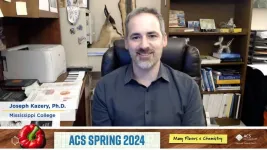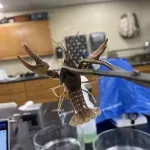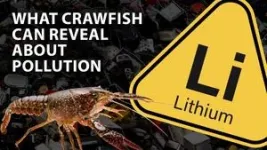The researchers will present their results today at the spring meeting of the American Chemical Society (ACS). ACS Spring 2024 is a hybrid meeting being held virtually and in person March 17-21; it features nearly 12,000 presentations on a range of science topics.
“As aquatic organisms, crawfish can take up large amounts of lithium dissolved in water. Because other creatures — including people — eat crawfish, looking at them allows us to see how lithium moves through the food chain, and potentially into us,” says Joseph Kazery, a professor of biology.
Two undergraduate students in Kazery’s lab at Mississippi College, Andrew Doubert and Javian Ervin, are presenting results of their experiments on uptake of ionic lithium by different crawfish organs, as well as the impact of seasonal temperatures. “If crawfish are raised near a landfill or a polluted site, runoff could expose them to lithium, with effects we don’t yet fully understand,” Ervin says. “I myself eat crawfish, so this issue is important to me.”
Lithium contamination is not new. Even before lithium-ion batteries became widespread, lithium was, and still is, used as a medication to treat mood disorders. It enters the water supply in those applications because typical wastewater treatment does not remove drug contaminants. At high levels, lithium can have toxic effects on human health, including potentially damaging heart muscle cells, as well as causing confusion and speech impairment. In other animals, it can cause kidney damage and hypothyroidism. Studies have also shown that when lithium accumulates in plants, it can inhibit their growth, Kazery says.
Although the U.S. Environmental Protection Agency recommends discarding lithium-ion batteries at dedicated collection points, Kazery says they often end up in landfills. Soaring demand along with lax disposal practices suggests lithium is on the verge of becoming a significant environmental contaminant, he says.
As fully aquatic organisms that spend their lives within a relatively small area, crawfish (Procambarus clarkii) reflect local lithium contamination and could serve as powerful bioindicators of its presence in an environment. The lithium they contain could be passed through the food chain to predators, including humans, either directly or indirectly through crawfish-eating fish that people consume.
For its experiments, the team purchased crawfish bred for research. Knowing that the liver collects toxins from the human body for subsequent removal, Doubert wondered whether lithium would accumulate in the crawfish version of this organ: the hepatopancreas. To find out, he added ionic lithium to food for five crawfish, while giving another five lithium-free food. He then examined the amount of lithium present in four of their organs after one week. He found, on average, the most lithium in the gastrointestinal (GI) tract, followed by the gills, the hepatopancreas and, finally, the abdominal muscle in the tail.
The researchers think the GI tract likely contained the highest level because the lithium-spiked food remains there during digestion. Meanwhile, the gills and the hepatopancreas both pick it up while removing it from the body. People predominantly eat the tail, which appears to take up lithium, but not as readily as the other body parts studied.
Doubert also found that 27.5% of the lithium he fed them had passed from the animals’ GI tracts into other tissues. Animals further up the food chain can accumulate higher levels of toxic substances if they eat contaminated prey, so lithium will likely become more concentrated in the predators of crawfish. The researchers expect the high rate of absorption Doubert saw to exacerbate this accumulation in both humans and the other animals that eat crawfish.
Water temperature that crawfish inhabit varies significantly throughout the year. Those shifts affect the animals’ metabolism, even causing them to become inactive during winter. Knowing this, Ervin decided to look at the effects of temperature on lithium uptake. He placed crawfish in tanks kept at temperatures as low as 50 degrees Fahrenheit and as high as 90 degrees Fahrenheit and added a consistent concentration of ionic lithium to the water. After five days, he found that lithium uptake by the abdominal muscle and a part of the crawfish that Doubert did not study — the animals’ exoskeleton — increased in the warmest tank. These results suggest that the animals may contain the most lithium during the warm months, according to Ervin.
The crawfishes’ weight also decreased in warmer water. At this point, it’s not clear how or whether the crawfishes’ weight loss was connected to the lithium they accumulated, Ervin says, noting that the team plans to follow up on these results.
“A lot of people think the use of lithium-ion batteries is a good thing right now, but it is important to explore the effects that may be coming down the road,” Doubert says.
The research was funded by Mississippi College’s Department of Biological Sciences and the Office of Research, Department of Student Research.
Visit the ACS Spring 2024 program to learn more about these presentations, “Absorption of lithium in the various organs of crayfish in a laboratory environment” and “Comparison of methods for determining stress in a crayfish model and environmental application,” and other scientific presentations.
###
The American Chemical Society (ACS) is a nonprofit organization chartered by the U.S. Congress. ACS’ mission is to advance the broader chemistry enterprise and its practitioners for the benefit of Earth and all its people. The Society is a global leader in promoting excellence in science education and providing access to chemistry-related information and research through its multiple research solutions, peer-reviewed journals, scientific conferences, eBooks and weekly news periodical Chemical & Engineering News. ACS journals are among the most cited, most trusted and most read within the scientific literature; however, ACS itself does not conduct chemical research. As a leader in scientific information solutions, its CAS division partners with global innovators to accelerate breakthroughs by curating, connecting and analyzing the world’s scientific knowledge. ACS’ main offices are in Washington, D.C., and Columbus, Ohio.
To automatically receive news releases from the American Chemical Society, contact newsroom@acs.org.
Note to journalists: Please report that this research was presented at a meeting of the American Chemical Society. ACS does not conduct research, but publishes and publicizes peer-reviewed scientific studies.
Follow us: X, formerly Twitter | Facebook | LinkedIn | Instagram
Title
Temperature effects on adsorption of a new pollutant in crayfish
Abstract
Crayfish are an integral part of an ecosystem and could pass on substances to different trophic levels as well reflect thermal changes in the environment by changing body mass and physiological changes in response to changing temperatures. Temperature can affect by crayfishes by influence ion imbalance and alter metabolic pathways. Lithium is found in a trace number of soils, rocks, and in the aquatic environment. Lithium batteries are currently found in phones, car batteries, and watches making them readily available in our environment due to the lack of correct disposal. The purpose of this study is to test lithium adsorption and absorption in crayfish in increasing water temperatures. Live Procambarus clarkii crayfish were placed in four temperature-controlled tanks measuring 10.0, 18.0, 25.0, and 32.0 °C, respectively. Specimens were maintained at a constant pH with a 1 mL/kg solution of lithium carbonate added in each tank. Crawfish biometric data was collected to determine variability of transport of lithium caused by temperature. The exoskeleton and abdomen were separated and digested using acid digestion procedures. These samples were analyzed in an ICP-OES. In this experiment we expect to find increasing concentration in the exoskeleton cuticle due to lithium adsorption in crayfish in respect to temperature.
Title
Absorption of lithium in the various organs of crayfish in a laboratory environment
Abstract
Heavy metals, such as lithium, are an upcoming contaminant. Lithium has many applications in alloys and batteries. With the increased use of lithium-ion batteries, it’s only a matter of time before they find their way into environmental ecosystems. Organisms such as crayfish can be utilized to determine heavy metal contamination because the freshwater crawfish, specifically Procambarus clarkii, accumulates heavy metals from water and sediments in which it lives. Crayfish are known as bottom-dwellers of their aquatic ecosystem and tend to accumulate metals in their tissues, but can also exhibit a high resilience to environmental and metal contamination. The purpose of this study is to determine the percent of absorption and translocation of lithium to various organs, as well as, to determine a hierarchical order of lithium in crayfish organs. Biometric data collected from the specimens was used to determine variations of transported lithium. Male and female Procambrius clarkii were fed 5 mg/kg of lithium-spiked food pellets. After several days, the hepatopancreas, gills, abdominal muscle, and intestines were removed, acid-digested, and then analyzed by an ICP-OES. Results are expected to yield higher concentrations of lithium in the digestive tract, followed by, the hepatopancreas as it is the organ that deals with the absorption and storage of digested food. Levels in the gills and abdominal muscles are expected to be of lower concentration.
END






